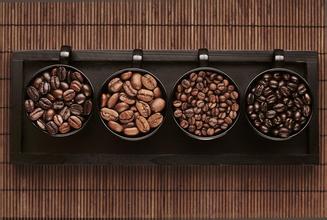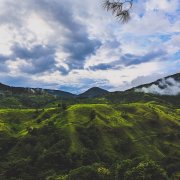Is Rwandan coffee suitable for washing? how does Rwandan coffee taste?
Later, batches of slaves were sold from Africa to Yemen and the Arabian Peninsula, and coffee was taken everywhere along the way. To be sure, Yemen started growing coffee in the 15th century or earlier. Although Arabia had the busiest port city in the world at that time, it banned the export of any seeds. This barrier was finally broken through by the Dutch, and in 1616, they finally smuggled the surviving coffee trees and seeds to the Netherlands and began to grow them in greenhouses.
Coffee tree editor
The coffee tree is an evergreen cotyledon plant native to Ethiopia and belongs to the Coffee genus of the Rubiaceae family in botany, with a height of up to 10 meters, while artificial growers are only two to four meters tall due to pruning. Coffee will probably seed in three to four years, and the yield will decrease after 20 to 25 years, but some coffee trees will still bear fruit after a hundred years of life. The branches of the coffee tree grow opposite and grow horizontally or drooping, while the leaves of the coffee tree are opposite on the short-diameter branches. The two main species are Arabica (Coffee Arabica) and Robasda (Coffee Robusta). The leaves of Arabica are about 15 centimeters long. Robasda's leaves are long, soft-oval or pointed, and bright green in color.
Origin legend editor
The Story of the Shepherd
The Story of the Shepherd: according to Rothschild Neroy (1613-1707), a Roman linguist, about
Coffee beans
Coffee beans
In the sixth century, when Kardai, an Arab shepherd, was herding sheep to the Isobian prairie for grazing, he was surprised to see that each goat was extremely excited and excited. After careful observation, he found that these sheep were excited only after eating some kind of red fruit. Cardai tasted some of them curiously and found that these fruits were very sweet and delicious, and he felt very refreshed after eating them. From then on, he often drove the sheep to eat this delicious fruit. Later, a Muslim passed through here and took some of this incredible red fruit home and distributed it to other parishioners, so its magical effect spread.
The Story of Shack Omar
Other legends are Shack, the guardian saint of the Arabian Peninsula. Chuck Omar, a disciple of Caldi, was a highly respected and beloved chief in Mocha, but he was expelled by his people for committing a crime. Shack. Omar was exiled to Osama in the country, where he stumbled upon the fruit of coffee in 1258. One day, Omar was walking hungry in the mountains and saw the birds on the branches pecking at the fruit of the trees. He took the fruit back and boiled it with water, but it unexpectedly gave out a rich and attractive fragrance, and the original feeling of fatigue was eliminated after drinking it. Omar collected many of these magical fruits, and when they met someone who was sick, they made the fruit into soup for them to drink and refreshed. Because he did good everywhere and was loved by believers, his sins were soon forgiven, and when he returned to Mocha, he was praised for finding this fruit, and people did not worship him as a saint. At that time, the magic cure was said to be coffee.
The Story of Deckley
This is a romantic story. Gabriel, a French naval officer on the island of Matinique, circa 1720 or 1723. Mathieu. De. As he was about to leave Paris, Klee managed to get some coffee trees and decided to take them back to Martinique. He had been taking good care of the saplings and keeping them in a glass box on the deck to protect them from sea water and heat. De. Klee was threatened by pirates during the journey, experienced the storm, and the jealousy and destruction of his fellow ship, and even saved his own water to water the sapling when drinking water was scarce. His coffee tree finally took root in Martinique and got its first harvest in 1726. It is said that by 1777 Martinique had 18791680 coffee trees, Gabriel. Mathieu. De. Klee played an important role. Gabriel. Mathieu. De. Klee died in Paris on November 30, 1724, and in 1918 a monument was built for him at the Ford Botanical Garden in Martinique, France.

Important Notice :
前街咖啡 FrontStreet Coffee has moved to new addredd:
FrontStreet Coffee Address: 315,Donghua East Road,GuangZhou
Tel:020 38364473
- Prev

What kind of coffee is more suitable for storing the origin of coffee culture in Rwanda?
The taste of Rwandan coffee is described as a grassy aroma with tropical climates. in addition to the sweetness of fruit, this coffee also gives people a feeling of freshness, clarity, and freshness. Bourbon coffee grown in Rwanda is amazing for its sweet fruit, full-bodied, unrestrained and lingering aftertaste. This kind of coffee is delicious.
- Next

Panama Carmen Boutique Coffee Estate
The best way to harvest fine coffee beans is to use manual harvesting. That is, only ripe coffee fruits are picked to prevent coffee fruits with inconsistent maturity from being picked at the same time. Fine coffee requires frequent and careful hand picking during harvest because underripe and overripe fruits affect the balance and stability of coffee flavor. Carmen Manor Coffee is a family-run coffee shop
Related
- Does Rose Summer choose Blue, Green or Red? Detailed explanation of Rose Summer Coffee plots and Classification in Panamanian Jade Manor
- What is the difference between the origin, producing area, processing plant, cooperative and manor of coffee beans?
- How fine does the espresso powder fit? how to grind the espresso?
- Sca coffee roasting degree color card coffee roasting degree 8 roasting color values what do you mean?
- The practice of lattes: how to make lattes at home
- Introduction to Indonesian Fine Coffee beans-- Java Coffee producing area of Indonesian Arabica Coffee
- How much will the flavor of light and medium roasted rose summer be expressed? What baking level is rose summer suitable for?
- Introduction to the characteristics of washing, sun-drying or wet-planing coffee commonly used in Mantenin, Indonesia
- Price characteristics of Arabica Coffee Bean Starbucks introduction to Manning Coffee Bean Taste producing area Variety Manor
- What is the authentic Yega flavor? What are the flavor characteristics of the really excellent Yejasuffi coffee beans?

